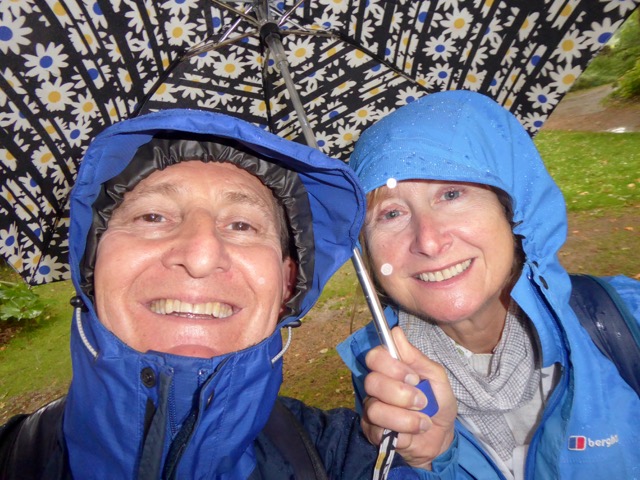After a quiet day on Sunday when we caught up with a few chores, mainly washing and cleaning, we had dinner at the campsite restaurant which is very popular. The food was great, although the portions are enormous – I ended up bringing half of mine back to the caravan to eat on Monday! Grant was intrigued to see horse steak on the menu – another evening perhaps?
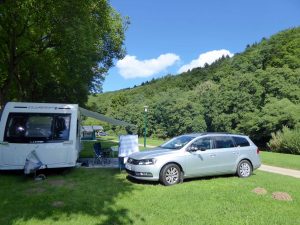
On Monday we visited Trier, the oldest city in Germany and the birthplace of Karl Marx. Trier was the western capital of the Roman Empire and became as important as Rome itself after Constantine I made it his administrative capital in the 3rd century AD. After driving round for half an hour trying to find a parking space, we eventually found the park and ride car park which was almost empty. Together with a young Dutch couple we found the bus stop (on the nearby bridge over the river Mosel, not in the car park) and I attempted to make myself understood with the lady bus driver. After a desperate cry to the passengers (on her part not mine) to ask if anyone spoke English, I managed to buy two return tickets, get the outbound tickets stamped in the machine, and she even shouted out to us when we should get off the bus and gave us directions to the Konstantin Basilica! We set off walking and realised that the city is very well sign posted, so we went off piste and headed for an early lunch with beer. German beer is fantastic and we see it as our mission to try as many brands as possible. The local beer here is Bitburger, and Diekirch, the Luxembourg beer, is also great.
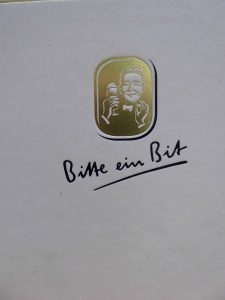
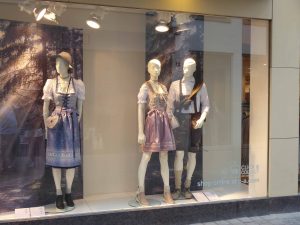
After lunch we set off to find the Konstantin Basilica.
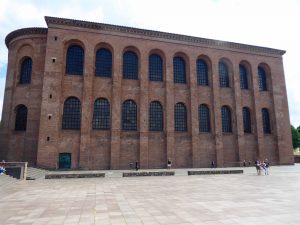
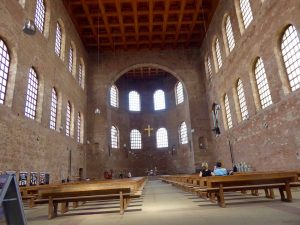
The original building was Roman and built as Emperor Constantine’s throne room, but it is now used as a Protestant church. The building was very badly damaged during WW2 but has been rebuilt almost as it was – it is enormous, and is the largest single room Roman structure still in existence. The interior and exterior are both austere – brick built walls and very simple seating and altar. We found it very moving. Right alongside the Basilica is the Kurfurstliches Palais which by contrast is very ornate, with beautiful gardens.
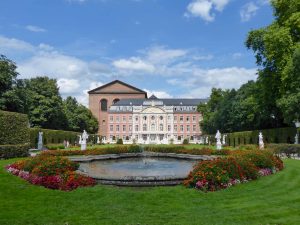
From here we headed to Liebfrauenstrasse to see the Church of our Lady, which is the oldest Gothic church in Germany, and the Trierer Dom, another Roman structure which is now Germany’s oldest bishop’s church. Of the two the interior of the Dom is much more decorative, and although both buildings were again bombed during the war it is amazing to see how well they have been restored.
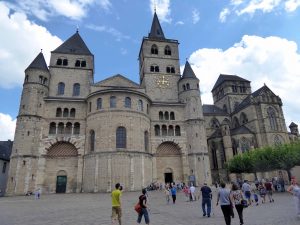
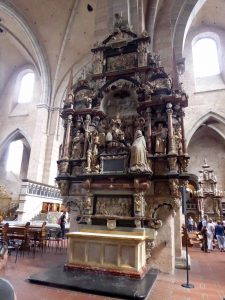
From here we walked on to the Hauptmarkt, a beautiful market square with stunning old buildings and then on to the Porta Nigra (black gate) a 2nd century Roman city gate which has blackened over the centuries.
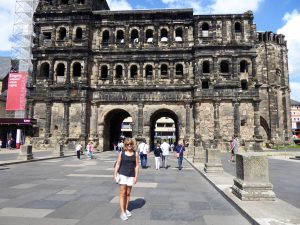
A Greek hermit called Simeon lived in the east tower for six years in the 11th century, and after his death he was buried inside the gate and later became a saint. We decided to catch the bus back to the car park from the area where we had been dropped off earlier, so set off in that direction but making a detour to see the Kaiserthermen, the ruins of a huge Roman thermal baths. This covered a very large area, and consisted of underground hot and cold water baths, boiler rooms and heating channels, with striped brick and stone arches. Very impressive, and it is being very sympathetically restored, although it was never finished in the first place, and was instead used as a barracks.
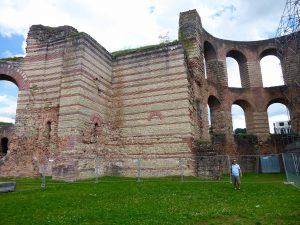
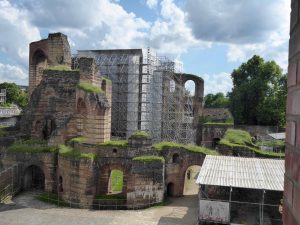
On the way back the satnav had another treat for us; the road we needed was closed – this seems to be a feature in Germany, where they signpost that a road is closed, but then don’t give you anything further, and leave you to sort it out for yourselves! The satnav found us an alternative route however, but when we were close to the campsite we received instructions to ‘take the ferry!’
As Trier is in Germany and we are staying in Luxembourg we had to get across the river Sure, and sure enough (!) there was a small car ferry, large enough for 6 vehicles, which took us across the river for 2 euros 70 cents! This will make a good trivea question though – Can you take a ferry from Germany into Luxembourg?
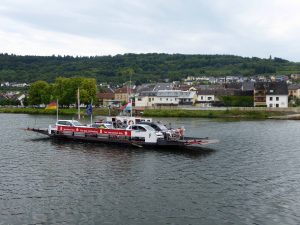
We are having real problems with wifi at this site so on Tuesday, after a quick shopping trip, we found a bar with free wifi so we could catch up with messages, upload photos and publish a blog. I suspect we will be doing that again today! We cycled 12km down to Wasserbillig (where the car ferry crosses the river) in the afternoon, a lovely flat cycle ride on a great cycle path right alongside the river, it was my kind of cycling!
We also met Clive, who hails from East Yorkshire. and introduced himself by giving us details of a tower ride that’s attached to a crane in Luxembourg City. He told us that he first came to this site with his wife over 30 years ago, and they came back every year for a long summer until she died a few years back. He continued to come back on his own, and during the second year discovered the owner’s wife had also become a widow. Long story short, they’re now a couple, and spend the winter months in Spain, the summer at the site in Luxembourg and their autumn’s in the UK. How about that for a happy ending eh?
We drove to the Mosel valley the next day as Sixe had mentioned how beautiful it is, and we plan to move the caravan there at the weekend for a few days. This is an important area for wine production, and the steep slopes on either side of the river are planted intensively with vines, right down to the roadside in most cases. Our first stop was Trittenheim, a small town right on the bank of the river with fabulous views all round. We stopped to watch a barge transporting coal down the river, then walked round the town looking for a cafe – unfortunately nowhere seemed to be open, so we moved to the next town, Neumagen, which was only 3km away. Neumagen (Noviomagus) is another town with Roman history, as it was home to a massive Roman fortification with 14 towers and 2 gates – again built for Constantine. There is still plenty of evidence of Roman times – we were especially taken with the Neumagen wine ship tomb. We had a quick lunch, more bratwurst for Grant, and a walk round the town before driving along the riverside to Bernkastel.
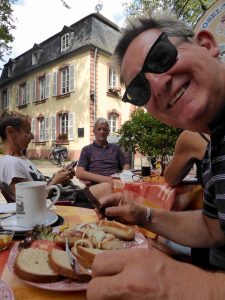
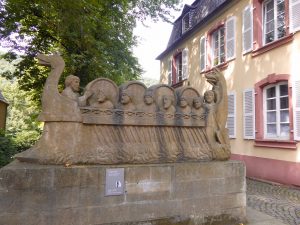
Bernkastel is one of the larger towns in the Mosel valley and is quite touristy, but most people seemed happy to sit in the cafes so we had no problem getting around. There is a very beautiful market square with half timbered buildings, the Landshut castle and so many vineyards in and around the town.
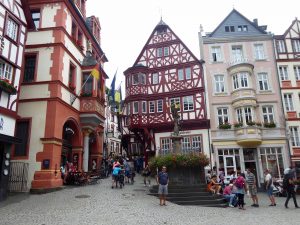
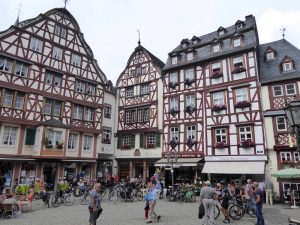
We agreed it was time we did some winetasting, so found a small shop owned by the Hansen-Lauer vineyard and the winemakers wife guided us through the different types of Mosel wine. We were very pleasantly surprised at the quality of the wine – we know very little about German wine but this was delicious, very clean and fresh. We bought a couple of bottles and then made our way back to the car.
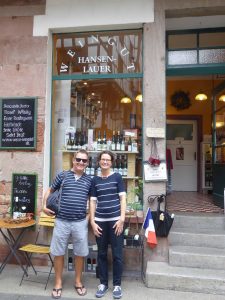
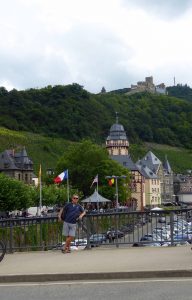
As soon as we got back to the campsite we booked our next site – in the Mosel valley.
